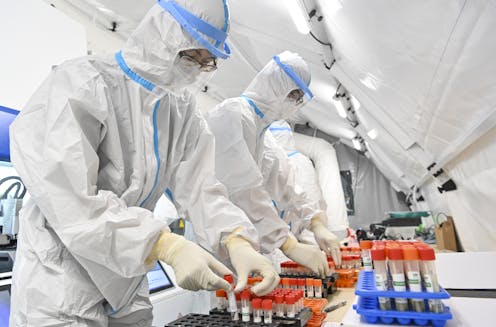The COVID-19 lab-leak hypothesis is plausible because accidents happen. I should know
- Written by Allen Rodrigo, Professor and Head, The School of Biological Sciences, University of Auckland

At the conclusion of the G7 summit yesterday, leaders called for a fresh and transparent investigation to determine how the COVID-19 pandemic began.
I welcome the renewed interest in the potential “lab-leak” origins of SARS-CoV-2, the virus that causes COVID-19. It wouldn’t be the first time an infectious pathogen was accidentally released from a research laboratory.
I know from personal experience. Back in 1994, on my first day of a fellowship at Stanford University, I picked up a damp courier parcel at reception and took it back to the lab. My professor put on latex gloves immediately. The parcel contained a vial with an HIV-infected lymph node.
The dry ice used to pack the sample had evaporated, soaking the cardboard. There I was, someone who had not worked with HIV before, with hands damp from handling a box containing live virus.
I didn’t get infected. But the experience left me acutely aware of how easily accidents happen. A 2018 review found 27 cases of laboratory-acquired infections between 1982 and 2016 in the Asia-Pacific region alone. The list of pathogens included everything from the virus that causes dengue fever to the SARS coronavirus.
Read more: Fifty-nine labs around world handle the deadliest pathogens – only a quarter score high on safety
The American Biological Safety Association (ABSA) maintains a searchable database of reported laboratory-acquired infections. It documents “leakage from the plastic bag in the negative-pressure transport chamber” and exposure to “droplets when cleaning a spill”, among many other examples.
From a scientific perspective alone, it is important to investigate the lab-leak hypothesis because, if true, we have to tighten safety procedures to prevent future leaks.
Two lab-leak hypotheses
When the virus was first reported from Wuhan almost 18 months ago, people have raised the possibility that it emerged from the Wuhan Institute of Virology, where research on SARS coronaviruses was underway.
This lab-leak hypothesis comes in two flavours. First, the virus could have jumped from an animal (or animal tissue) infected with a SARS coronavirus as part of the research. The infected person subsequently infected others in the community.
The transfer of a pathogen from an animal to people is called a zoonotic transmission. This process also occurs outside of laboratories, perhaps when there is close contact with infected animals or they are eaten.
The second hypothesis suggests a purposeful genetic modification of a coronavirus that gave rise to a more infectious and human-transmissible variant, which then leaked into the community. This type of genetic modification is called gain-of-function, because the engineered virus acquires new biological traits.
It is unfortunate these hypotheses have been miscast as somehow equivalent, and often portrayed as alternative to the “natural origins” hypothesis.
When I and other computational biologists think of origins, we think about evolutionary ancestors: a virus’ evolutionary line of descent. If SARS-CoV-2 had evolved without human intervention from an ancestral variant found in one or more hosts, it is quite possible that such a host animal, or a sample from an infected host animal, was the subject of study in a lab.
Through some unfortunate misadventure, it is plausible that someone in that lab became infected.
Why an investigation is important
Arguments for or against these hypotheses are often couched in terms of likelihoods. In February, the World Health Organisation (WHO) listed four scenarios in its global study of SARS-CoV-2 origins: direct zoonotic transmission, indirect zoonotic transmission through an intermediate host, transmission through cold/food-chain products and accidental laboratory release.
Indirect zoonotic transmission through an intermediate host was deemed “likely to very likely” and accidental lab release “extremely unlikely”. The WHO panel rejected deliberate gain-of-function manipulation because it “has been ruled out by other scientists following analyses of the genome”.
But that wasn’t the last word, because the exact origin of the COVID-19 virus remains a mystery.
Read more: The COVID-19 lab leak theory highlights a glaring lack of global biosecurity regulation
Genome sequencing of SARS-CoV-2 has shown the virus is related (about 96%) to a strain found in horseshoe bats. Although this seems like a high level of similarity, it implies that SARS-CoV-2 diverged from this strain several decades ago. Therefore, it remains unclear if the spillover was directly to humans or through an intermediate species.
In any case, such evolutionary analysis cannot distinguish between transmission in or outside a laboratory.
The WHO panel considered a lab-acquired infection as extremely unlikely because of the Wuhan laboratories’ strict biosafety protocols. But the ABSA database lists accidental infections happening even in labs with the highest biosafety accreditation, and these include SARS-coronavirus infections.
Read more: The next pandemic is already happening – targeted disease surveillance can help prevent it
In its arguments for and against accidental lab release, the WHO report noted the Wuhan laboratories moved to a new location near the Huanan market in early December 2019, but “reported no disruptions or incidents caused by the move”. There is no reason to distrust the WHO panel’s conclusions, but it is nonetheless true that lab relocations present opportunities for error.
The lab-leak hypothesis is at least plausible and it’s therefore important to investigate it. If it were related to the operations of the lab, or its relocation, we need to re-examine safety protocols. For relocations, we may want to require independent monitoring and pre- and post-move quarantine of essential personnel.
Authors: Allen Rodrigo, Professor and Head, The School of Biological Sciences, University of Auckland





